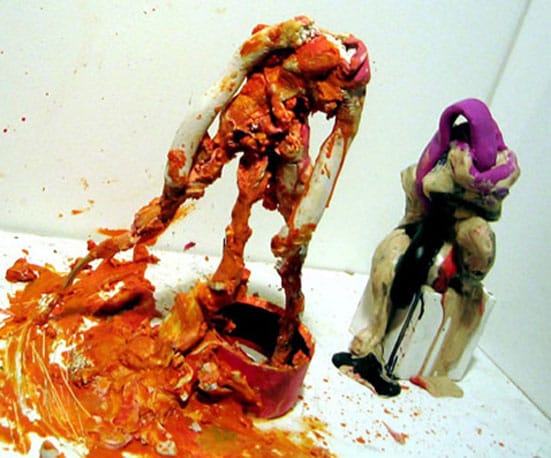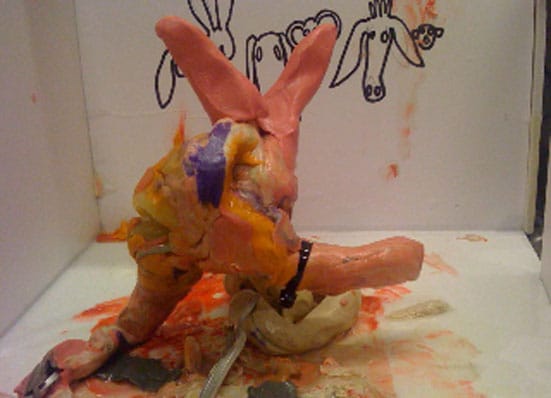Alma Enterprises opens its new space in Southwark on 1 May with a solo show by Neil Hedger. See www.almaenterprises.com for full details. I caught up with Alma directors, Ben Tomlinson and Charlie Tweed, and sculptor Neil Hedger to find out more.
BEN TOMLINSON AND CHARLIE TWEED
AM: Could you tell me something about the history of Alma, how and when it was set up, who was involved and how you met?
BT/CT: Before Alma opened we all worked together in various guises curating exhibitions in other spaces sometimes under the name of LAND. As LAND we curated a series of video and performance based shows which were exhibited in London in galleries such as the Gasworks and in the USA. We also managed some artist’s projects such as Vauxhall Pleasure in 2004 with Anna Best and Paul Whitty which took place at Vauxhall Cross and Tate Britain.
We first found the space at 1 Vyner Street in 2004 and until late last year it was run by ourselves and with Sara Watkins and Siobhan Wootton. Interestingly, we were initially looking at a much larger space in Elephant & Castle (which is close to our new location) as there seemed such potential in the area.
As a group of artists and curators we were interested in developing group shows and solo shows with an emphasis on performance, video and sound based work. We also invited some external curators to realise their projects there such as Ellen Mara de Wachter who curated the show ‘Arsenal’ in 2006 as well as Anna Colin and Tobi Maier who curated ‘Six Sites for Sound’ in 2005 (with Jem Finer exhibiting in Alma).
We also wanted to encourage the artists showing to work site-specifically and think about the history of the space, its location and the dynamics of the ever-increasing commercial art hub of Vyner Street. There are some projects that particularly focussed on this such as Brian Catling’s durational performance in 2007 which summoned up an uncanny feeling of the past present and future history of the space and its surroundings. Also Michael Curran directed Hayley Newman in ‘Luck Be A Lady Tonight’ in 2007 and took over the entire space with an installation of hanging mirrors accompanied by the drummer from the band Selfish C*nt. Finally Kim Noble created a durational performance consisting of multiple plans for using the space and interacted with gallery visitors whilst hanging precariously from the ceiling on an electric winch.
AM: Could you tell me about your new space in Glasshill Street? You were a pioneer of the Vyner Street scene, how did you come to relocate to Southwark? Do you think you are setting a new trend. If and how will this new milieu shape Alma’s practice?
BT/CT: When we moved to Vyner Street there was only one other gallery on the street (for a couple of weeks anyway) and we chose the space because of its geographical location as well as the challenging shape of the gallery. We were happy to have extra visitors as the amount of galleries increased, but in the last year the whole area began to feel that it had been drained and being forced to move has given us time to reflect on what we are trying to achieve with the gallery.
Southwark as a location is exciting as it is still in a constant state of development and the history of the area and our specific location will be something that we will explore as curators. The area could certainly benefit from more contemporary galleries arriving and we believe that South London will certainly be a new focus for the art scene with the impact of 2012 on the East End. But we also enjoy operating in an area which is slightly removed from the over populated scene in the East and the opportunity to independently plough our own furrow as a space is important to us.
AM: Do you have a new manifesto for your new incarnation?
BT/CT: Indeed we do. Our curatorial focus will be informed by a principal construct of working with individual artists showing singular pieces of work. This work will often be developed during a period of time as a residency within the space itself (as in the case of Neil Hedger).
We wanted to keep it as simple as possible whilst also not giving us too much room for ambiguity, we are interested in developing a close working relationship with the selected artists over a period of time so that the work has a relevant narrative to our curatorial intentions and the artist’s relationship with the space. (so that it does not appear to be parachuted in there)
AM: What have been some of the highlights for you of Alma’s programme over the years?
BT/CT: When we showed ‘It’s Just Bread’ in 2007 we had reached a point of understanding in the type of surveys we wanted to realise. It had the ideal mix of a performance programme and film that introduced emerging artists such as allsopp&weir and Thomas Altheimer as well as established artists such as Brian Catling, and Hayley Newman and artists not shown in the UK such as Belgian Fluxus artist Ludo Mich.
AM: What exciting projects do you now have in store for the London art-going public?
BT/CT: The inaugural show will be a solo show with Neil Hedger in May (see interview below) and then we will be having a series of weekend performances in September each time we will commission an individual artist to create a site specific inhabitation of the space for a weekend. We can also reveal that we will be showing a very established artist in October in a solo show and then Katie Cuddon will be showing a new sculpture in a solo show at the end of 2009 (fresh from her residency at the British School of Rome).
NEIL HEDGER
AM: How does your inaugural exhibition at the new Alma space, A Day at the Races mark a new development in your practice?
NH: The significant development is the presentation of these shapes on a large scale. The body of work has developed to work on a miniature scale; a large object can impress simply through its relative scale, and I wanted to be sure that the work functioned through its shape before moving into the territory of the larger object.
AM: What unique challenges have you faced with this project?
NH: The biggest challenge will be finding out how these shapes react to the increase in size. The plan is to crowd the space, which may not leave much room for the viewer, but the materials will remain the same as the smaller work- wax paint tinfoil etc- so it’ll be interesting to see how everything works in relation to the viewer in a more claustrophobic or intimate setting.
AM: What are some of the varied points of departure you take in your sculptural works?
NH: The main critical departure point is Bataille, in particular his suggestion that sculpture is nothing more than the erection of milestones ‘marking the immensity of an un-limitable catastrophe’. I’m interested in finding the right shape and materiality for these milestones.
Ali MacGilp

Neil Hedger, Celebrity, 2008 (plasticine, wax, aluminium, wood, paint)

Neil Hedger, A Day at the Races, 2009 (plasticine, wax, aluminium, paint)